The Generator Effect
1/19
There's no tags or description
Looks like no tags are added yet.
Name | Mastery | Learn | Test | Matching | Spaced |
|---|
No study sessions yet.
20 Terms
The generator effect is the opposite of the…
motor effect. Instead of electricity being used to create motion, motion is being used to create electricity.
What is the Generator Effect?
If an electrical conductor moves relative to a magnetic field or if there is a change in the magnetic field around a conductor, a potential difference is induced across the ends of the conductor.
How can you induce a potential difference?
By moving a conductor relative (wire) to a magnetic field - cutting through the field lines and therefore inducing a potential difference in the wire.
Or moving the magnet in a coil of wire - as the magnet moves through the coil, the field lines cut through the turns on the coil - inducing a potential difference in the coil
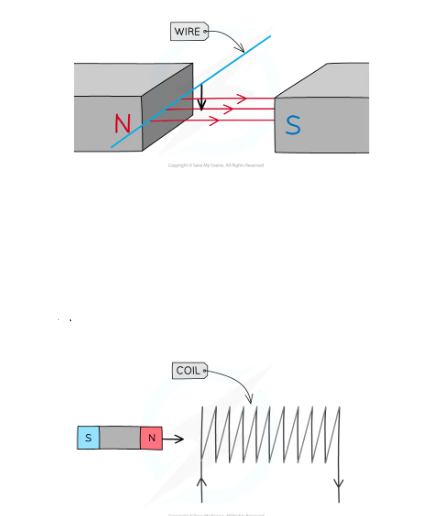
What is the requirement for an induced potential difference to cause a current to flow?
The conductor must form a closed loop or be part of a complete circuit.
What happens when you move the magnet or conductor in the opposite direction?
Then the potential difference or current will be reversed.
Factors affecting the induced potential difference:
speed at which the wire, coil or magnet is moved - increasing the speed increases the rate at which field lines are cut - increases p.d.
number of turns on the coils in the wire - more coils = more potential difference induced because each coil cuts through the magnetic field lines and the total p.d. induced is the result of all the coils cutting the field lines
size of the coil - increasing area of coils increases p.d. - more wire to cut through magnetic field lines
strength of magnetic field - increasing strength increases p.d. induced
What does Lenz’s law state?
The direction of an induced potential difference always opposes the change that produces it.
What happens when a magnet is pushed north end first into a coil of wire?
The end of the coil closest to the magnet becomes a north pole. This is because, due to the generator effect, a potential difference will be induced in the coil and this potential difference always opposes the change that produces it. This means the coil will apply a force to oppose the magnet being pushed into the coil. Therefore, the end of the coil closest to the magnet will become a north pole so it will repel the north pole of the magnet.
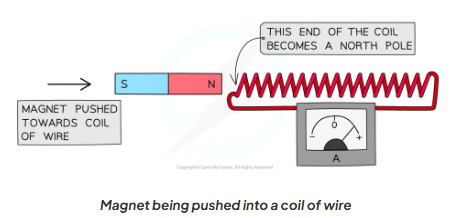
What happens when a magnet is pulled away from the coil of wire?
The end of the coil closest to the magnet becomes a south pole. This is because, due to the generator effect, a potential difference will be induced in the coil and this induced potential difference always opposes the change that produces it. So the coil will apply a force to oppose the magnet being pulled away from the coil. This means the end of the coil closest to the magnet becomes a south pole so it will attract the north pole of the magnet.
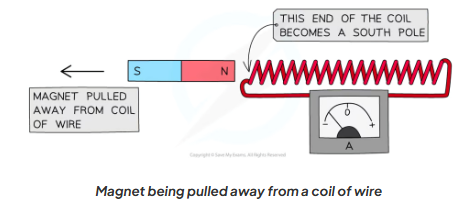
Describe how rotation of a magnet can cause the Generator Effect:
As the magnet turns, the magnetic field through the coil changes, which induces a potential difference (p.d.) and can cause a current to flow.
Every half turn, the magnetic field reverses, so the p.d. and current reverse direction.
If you keep rotating the magnet (e.g. clockwise), the p.d. keeps reversing every half turn — this produces an alternating current (a.c.)
Applications of a the generator effect:
To generate a.c. in an alternator
To generate d.c. in a dynamo
What is a simple alternator?
A type of generator that turns mechanical energy to electrical energy in the form of alternating current.
Describe how alternators generate alternating current:
An alternator generates electricity by rotating a coil in a magnetic field, or rotating a magnet inside a coil.
As the coil or magnet spins, the magnetic field through the coil changes, which induces a potential difference (p.d.) across the coil.
The direction of the induced p.d. reverses every half turn, so the current changes direction — producing an alternating current (a.c.).
Slip rings and brushes are used instead of a split-ring commutator.
Slip rings allow the coil to stay connected to the external circuit without swapping contacts, so the alternating p.d. is transferred directly.
This setup allows the output to be a smooth alternating current.
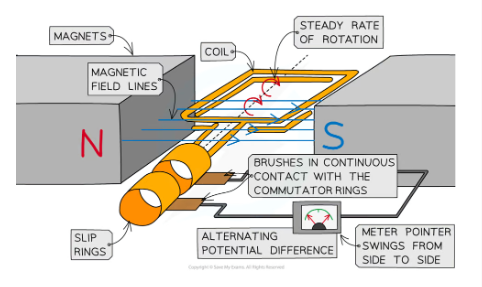
What do the slip rings and brushes provide between the coil and the voltmeter?
A continuous connection.
Describe how Dynamos generate direct current:
They work in the same way as an alternator but have a split-ring commutator instead of 2 separate slip rings. This swaps the connection every half turn to keep the current flowing in the same direction. So the induced pd does not reverse its direction and instead varies from zero to a maximum value twice each cycle of rotation & never changes polarity - current is always positive or negative.
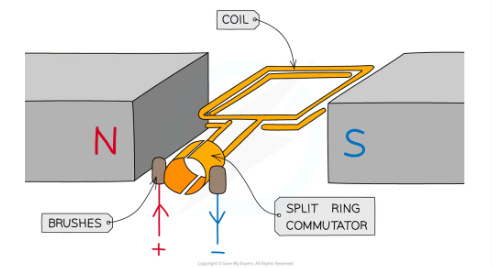
Alternator a.c output:
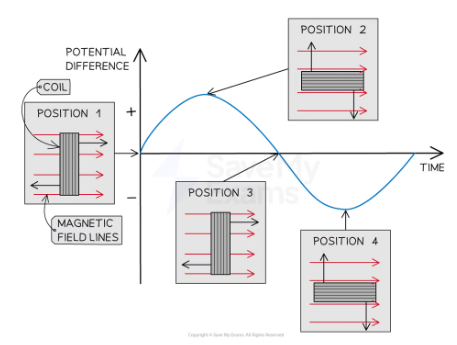
Dynamo d.c. output:

What device is used to show how potential difference generated in a coil changes over time?
An oscilloscope.
How do microphones use the generator effect?
They convert sound waves into electrical current.
When sound waves reach the microphone, pressure variations in the air cause a diaphragm to vibrate.
The diaphragm is attached to a coil of wire, which is placed in a magnetic field produced by a magnet.
As the diaphragm vibrates, the coil moves back and forth, cutting through the magnetic field lines.
This movement induces a potential difference across the coil
Because the sound wave is constantly changing, the coil moves in different directions, producing an alternating potential difference (AC). Which creates an alternating current (AC) in the circuit.
The alternating current mirrors the frequency and amplitude of the original sound wave.
